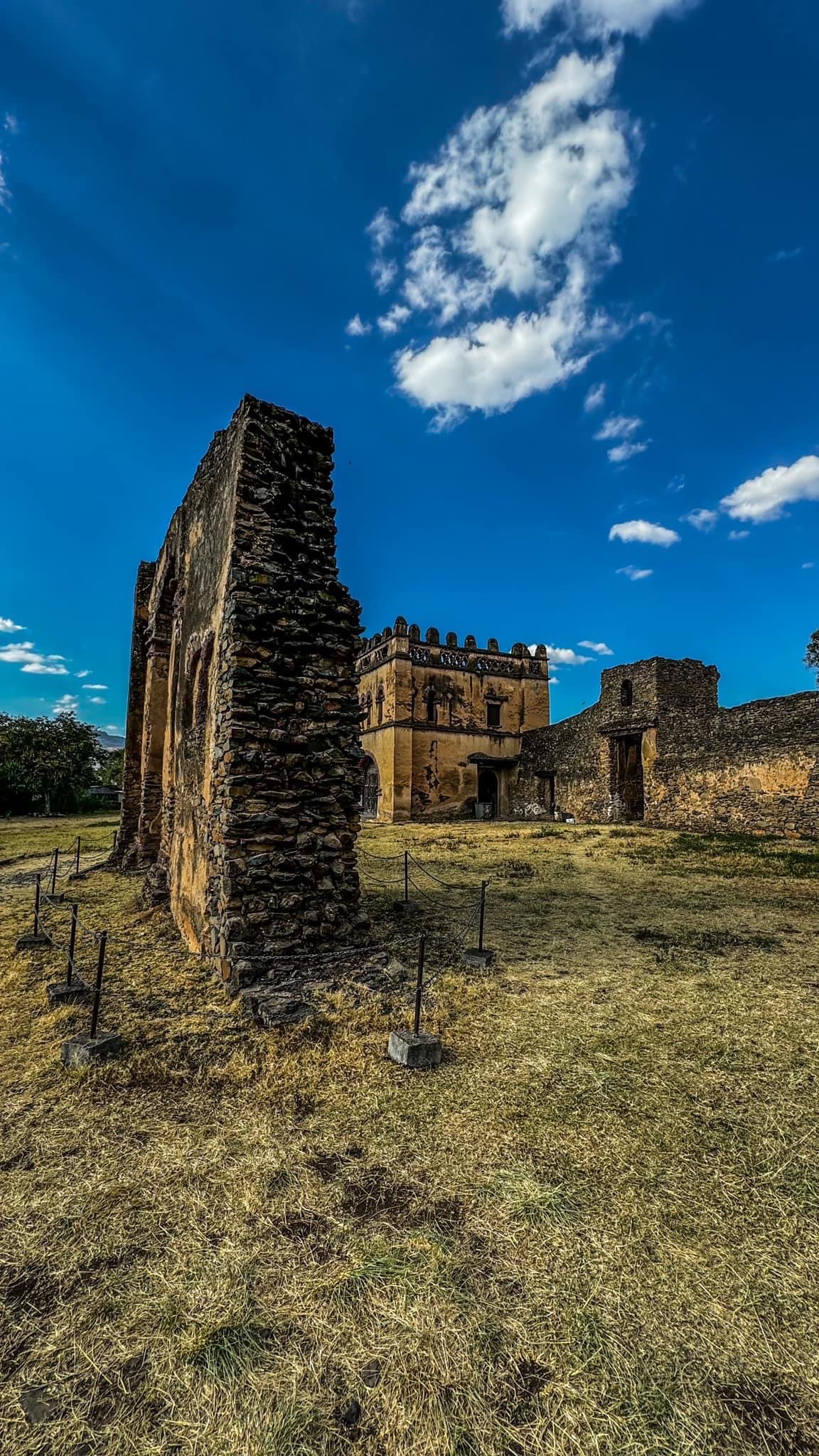Trip To the Gondar City of Ethiopia, Tourist Attractions and Activities In Gondar Town
The Historical Gondar City is located in the North Gondar Zone of the Amhara Region, Gondar is north of Lake Tana on the Lesser Angereb River and southwest of the Simien Mountains. As of 2023, Gondar has an estimated population of 487,224. Gondar previously served as the capital of both the Ethiopian Empire and the subsequent Begemder Province. (Gondar was the capital of Ethiopia from 1636 until the mid-19th century. Gonder combines a modern veneer with an architectural sensibility harking back to the Middle Ages. The city’s physical and architectural centerpiece is Fasil Ghebbi, a stonewalled Royal Compound containing half a dozen fairytale castles including the three-story original built by Emperor Fasil in the 1630s. The Fasil Ghebbi UNESCO World Heritage Site also incorporates several more remote constructions, most notably the Church of Debre Berhan Selassie, with its beautifully painted interior.
The castle was the medieval home to Ethiopian Emperors and Princesses who led the country for nearly 1000 years. Once you have reached the main site, check out the Royal Enclosure which is home to the main attractions in the city. Another site not to miss is Fasiladas’ Bath. This is where the annual Timkat celebration takes place. The water is blessed by the bishop and splashed on the crowd of pilgrims who come to renew their faith and to take part in the ceremony that replicates Christ’s baptism in the Jordan River. Whilst here don’t forget to visit Debre Berhan Selassie, which is considered to be one of the most beautiful churches in all of Ethiopia.

Things to do in Gondar City:
Explore Fasil Ghebbi (Royal enclosure):
Towering over Gonder amongst a sea of faded colonial-era buildings, The Royal Enclosure, also known as ‘Fasil Ghebbi, was built in the 1600s by Emperor Fasilides. Right in the centre of the city, there are six castles enclosed by an impressive 900-metre-long stone wall. These castles served as the primary residence for the Ethiopian royal family and fulfilled this function until 1864.
One of the few UNESCO world heritage sites in sub-Saharan Africa, the buildings were once adorned in ornate decorations, sourced from all corners of the known world, and were celebrated as an architectural marvel when built. The compound has diverse architectural influences, including Arab, Hindu, and Baroque styles. It is made up of churches, palaces, and public and private buildings such as libraries, banquet halls, and stables.

Explore Fasiladas’ Bath:
Fasiladas’ Bath, also called Fasil Mewagna by locals, is a place of beauty, worship, and celebration. Much of the history surrounding the conception and construction of these buildings is clouded in mystery. In its prime, the structure served as a retreat for the royal family.
Built around the same time as Fasil Ghebbi, the bathhouse has taken on various functions over the centuries. Today, it is the evangelical epicenter for Ethiopian Christians every January during the festival of Timkat. On the 19th of January, the bone-dry bathhouse is once again filled with water for Timket, a yearly festival re-enacting Jesus’ baptism in the River Jordan.
Visit Fasiladas' Pool:
Fasiladas' Pool is one of the top attractions in Gondar, Ethiopia. Located within the Royal Enclosure, this historic site holds great significance in Ethiopian history and is a must-visit for tourists. Built in the 17th century by Emperor Fasiladas, the pool was originally used for religious ceremonies, including the famous Timkat festival. Timkat is a religious holiday celebrated by Ethiopians to commemorate the baptism of Jesus Christ. During this festival, the pool comes alive with colorful processions, singing, and dancing, creating a truly vibrant atmosphere.

Visit Debre Birhan Selassie Church:
Known worldwide for its brightly colored frescoes and vivid depictions of various biblical tales, Debre Birhan Selassie is considered one of the most important churches for Ethiopian Orthodox Christians. Built in the 17th century by Emperor Eyasu II, the church is surrounded by a row of twelve stone towers, each representing one of the 12 apostles. The interior walls of Debre Birhan Selassie (meaning 'Light of the Trinity') are adorned with vivid depictions of biblical events.
Visit Falasha Village:
Once the focal point for the Jewish faith in Ethiopia, not much life remains in Falash Village after the last of its residents fled to Israel in the 1980s.
An eerie remnant of antiquity, this once thriving hub is sadly swallowed by the pressure of prejudice and is now a ghost town. Around 3km north of Gondar, there are several craft stalls dotted around the now desolate streets, selling tidbits and mementos of the now non-existent culture that once infused this land. Known for their amazing craft skills, these Ethiopian Jews - known as Falasha - were often abused at the hands of the Christian majority, with much of the pottery and fine art they were known for sadly lost to the sands of time.
Visit Simiens Mountains National Park:
Gonder is the gateway town into the Simien Mountains National Park, and most visitors will fly into Gonder, spend a day or two exploring the city, and then head up into the mountains. It is a roughly 3-hour drive from Gonder to the Simiens.
Visit Gondar Market:
Located in the heart of the city, Gondar Market offers an authentic Ethiopian shopping experience. It is a must-visit destination for both locals and tourists who want to immerse themselves in the local culture and indulge in a shopping spree.
At Gondar Market, visitors can browse through a wide range of traditional handicrafts, textiles, jewelry, and artifacts. The market is known for its unique collection of Ethiopian crafts, including intricate wood carvings, handwoven textiles, and colorful clothing.
Dining at the Four Sisters Restaurant:
Considered one of the best eateries in Gonder, the four sisters restaurant has been serving up a range of delicious local and international dishes for decades and has a long line of happy customers. If you want to sample local food, the four sisters offer plenty of local cuisine including a range of vegan and vegetarian options. For those looking for home comforts, the restaurant is known for its take on many Western classics. The restaurant has a great atmosphere, and a nice outdoor seating area, and is one of the best spots to spend the evening in Gonder.
Visit Kuskuam Church:
Kuskuam Church is a mountaintop monastery two miles from central Gonder. Many of the paintings that originally decorated these walls have now been moved to the Debre Berhan Selassie church, however, in their place a range of more modern artwork adorns the stone walls, unique in a land full of archaic churches full of centuries-old art.
Visit Qusquam Monastery:
This ancient monastery holds significant historical and religious value, making it a must-visit destination for tourists. Constructed in the 15th century, the Qusquam Monastery serves as a holy site for Ethiopian Orthodox Christianity. It is believed to have been founded by renowned monk Abune Yakob and is dedicated to Saint Mary. The monastery showcases exemplary Ethiopian architecture, with its stone walls and beautifully painted frescoes.

The Qusquam Monastery is a peaceful and serene place surrounded by stunning natural scenery. Visitors can explore its religious structures, including the main church, chapels, and prayer rooms. The standout feature of the monastery is the crypt, which houses the remains of various Ethiopian emperors and saints. Around the church, several small museums can be found, with a range of ancient Ethiopian literature, art, and what remains of the three rulers who helped construct the site. Buildings have been found on site as far back as the early 1600s, with a church founded by Empress Mentewab lying underneath the current structure.
Email: This email address is being protected from spambots. You need JavaScript enabled to view it.
Mobile: +256 705 087 906 / 760 282 342

